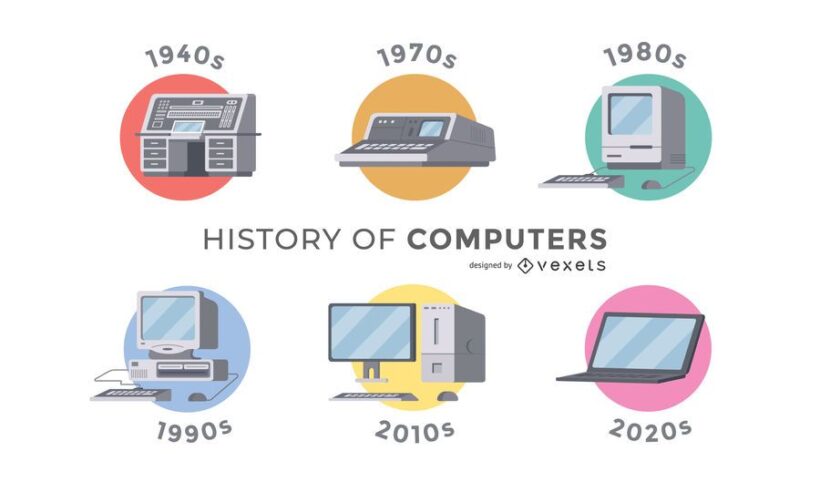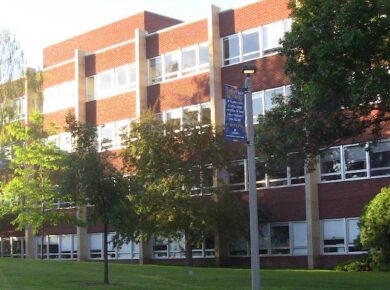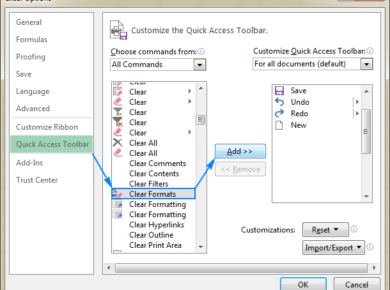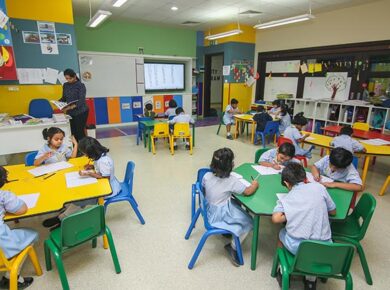Called the “Model K” adder because he built it on his “kitchen” table, this simple display circuit provides a proof of concept for applying Boolean logic to the design of computers, resulting in a relay-based model. Complex calculators were created in 1939. That same year in Germany, engineer Konrad Zuse built his Z2 computer using the telephone company Relay.
1939
Hewlett-Packard Is Founded
Hewlett And Packard In Their Garage Workshop
David Packard and Bill Hewlett found their company in a Palo Alto, California garage. Their first product, the HP 200a audio oscillator, quickly became a popular piece of test equipment for engineers. Walt Disney Pictures ordered eight of the 200B models to test recording equipment and speaker systems for 12 specially equipped theaters showing the film “Fantasia” in 1940.
1940
Complex Number Calculator (Cnc) Is Complete
Operator In Complex Number Calculator (Cnc)
In 1939, Bell Telephone Laboratories perfected this calculator designed by scientist George Stibitz. In 1940, Stibitz demonstrated CNC at an American Mathematical Society conference held at Dartmouth College. Stibitz surprised the group by performing calculations remotely over a CNC (located in New York City) using a teletype terminal connected to New York over special telephone lines. This is probably the first example of remote access computing.
Visit here clynerr.com
1941
Konrad Zuse Completes The Z3 Computer
Zuse Z3 Computer
The Z3 is an early computer built by German engineer Konrad Zuse that operates in complete isolation from developments elsewhere, uses 2,300 relays, performs floating point binary arithmetic, and has a 22-bit word length. . The Z3 was used for aerodynamic calculations, but was destroyed in a bombing raid on Berlin in late 1943. Zuse later oversaw the reconstruction of the Z3 in the 1960s, which is currently on display at the Deutsche Museum in Munich.
First Bombay Is Completed
Bombay Replica, Bletchley Park, Uk
Built during World War II as an electro-mechanical means of decrypting Nazi ENIGMA-based military communications, the British Bombay is conceived by computer pioneer Alan Turing and Harold Keane of the British Tabulating Machine Company. Hundreds of Allied bombs were built to determine the daily rotor start positions of the Enigma cipher machines, allowing the Allies to decrypt German messages. The original idea for the bombs came from Polish code-breaker Marian Rzewski’s 1938 “Bomba”.
Get to more interesting topics here how to clean macbook screen
1942
The Atanasoff-Berry Computer (Abc) Is Complete
Atanasoff-Berry Computer
After successfully demonstrating a proof-of-concept prototype in 1939, Professor John Vincent Atanasoff receives funding to build a full-scale machine at Iowa State College (now the University). The machine was designed and built between 1939 and 1942 by Atanasoff and graduate student Clifford Berry. ABC was at the center of a patent dispute related to the invention of the computer, which was resolved in 1973 when it was shown that ENIAC co-designer John Mauchly had seen the ABC go into action soon after.
The legal result was a milestone: Atanasoff was declared the originator of many basic computer ideas, but the computer as a concept was declared non-patentable and thus freely open to all. A full-scale working replica of the ABC was completed in 1997, proving that the ABC machine worked as claimed by Atanasoff. The replica is currently on display at the Computer History Museum.
1943
Bell Labs Relay Interpolator Is Complete
George Stibitz Circa 1940
The US military asked Bell Laboratories to design a machine to aid in testing its M-9 Gun Director, a type of analog computer that aimed large guns at their targets. Mathematician George Stibitz recommends using a relay-based calculator for the project. The result was the relay interpolator, later called the Bell Labs Model II. The relay interpolator used the 440 relay, and since it was programmable by paper tape, it was used for other applications after the war.
Kurt Herzstark was an Austrian engineer who worked in his family’s construction business until he was arrested by the Nazis in 1943. While imprisoned in the Buchenwald concentration camp for the rest of World War II, he refined his pre-war design of a calculator with a modified characteristic. Leibniz’s version of the “stepped drum” design. After the war, Herzstark’s Curta made history as the smallest all-mechanical, four-function calculator ever built.
While many early digital computers were based on similar designs, such as the IAS and its copies, others have unique designs, such as the CSIRAC. Built in Sydney, Australia by the Council of Scientific and Industrial Research for use in its radio physics laboratory in Sydney, CSIRAC was designed by British-born Trevor Pierce, and used the unusual 12-hole paper tape. It was transferred to the Department of Physics at the University of Melbourne in 1955 and remained in service until 1964.
Edsac Completed
Edsac
The first practical stored-program computer to provide regular computing service, the EDSAC is built at the University of Cambridge using vacuum tubes and mercury delay lines for memory. The EDSAC project was led by Maurice Wilkes, Professor at Cambridge and Director of the Cambridge Computation Laboratory. Wilkes’ ideas developed from lectures at the Moore School, which he had attended three years earlier. A major advance in programming was the use by Wilkes of a library of short programs called “subroutines”, stored on perforated paper tape and used to calculate common repetitions within a ledger program.
Made Developed
Maddida (Magnetic Drum Digital Differential Analyzer) Prototype
MADDIDA is a digital drum-based differential analyzer. This type of computer is useful in performing many mathematical equations that scientists and engineers encounter in their work. It was originally built in 1949 for a nuclear missile design project by a team led by Fred Steele. It used 53 vacuum tubes and hundreds of germanium diodes with magnetic drums for memory. The tracks on the drums performed mathematical integration. MADDIDA was sent across the country to perform for John von Neumann, who was impressed. Northrop was initially reluctant to make MADDIDA a commercial product, but by the end of 1952, six had been sold.
Manchester Mark I Completed
Manchester Mark I
Built by a team led by engineers Frederick Williams and Tom Kilburn, the Mark I serves as the prototype for Ferranti’s first computer – the Ferranti Mark 1. The Manchester Mark I used over 1,300 vacuum tubes and occupied an area the size of a medium room. , Its “Williams–Kilburn tube” memory system was later adopted by many other early computer systems around the world.
1950
Era 1101 Introduced
Era 1101
One of the first commercially manufactured computers, the company’s first customer was the US Navy. The 1101 was designed by ERA but built by Remington-Rand, for high-speed computing and stored 1 million bits on its magnetic drum, one of the earliest magnetic storage devices and a technology developed by ERA. He had done a lot to perfect himself. laboratories. Many of the 1101’s basic architectural details were re-used in later Remington-Rand computers until the 1960s.
Npl Pilot Ace Completed
Pilot Ace
Britain’s pilot ACE computer has been built at the National Physical Laboratory, based on ideas from Alan Turing. “We’re trying to build a machine to do all kinds of different things by simply programming, rather than adding additional equipment,” Turing said in 1947 at a symposium on large-scale digital computing machinery in Cambridge, Massachusetts. The design packed 800 vacuum tubes into a relatively compact 12 square feet.
The hobbyist magazine Radio Electronics published Edmund Berkeley’s design for the Simon 1 relay computer from 1950 to 1951. The Simon 1 used relay logic and cost about $600 to build. Berkeley wrote in his book Giant Brains – “We shall now consider how we can design a very simple machine that will think. Let us call it Simon, because its predecessor, the Simple Simon … Simon So simple and so small in fact that it can be made to fill less space than a grocery store can; about four cubic feet.”
Seac And Swac Completed
The Standard Eastern Automated Computer (SEAC) is one of the first stored program computers completed in the United States. It was built in Washington DC as a test-bed for evaluating components and systems as well as setting computer standards. It was one of the first computers to use all-diode logic, a more reliable technology than vacuum tubes. The world’s first scanned image was made at the SEAC in 1957 by engineer Russell Kirsch.
NBS also built the Standard Western Automated Computer (SWAC) at the Institute for Numerical Analysis on the UCLA campus. Instead of testing components like SEAC, SWAC was built using previously developed technology. SWAC was used to solve problems in numerical analysis, including developing climate models and discovering five previously unknown Mersenne prime numbers.






